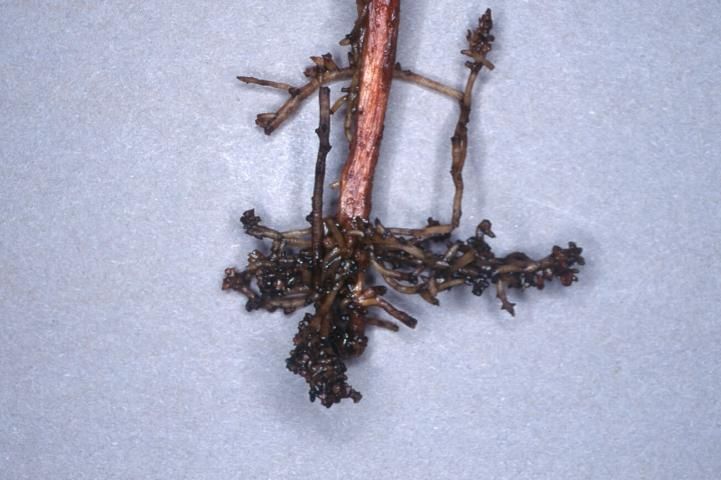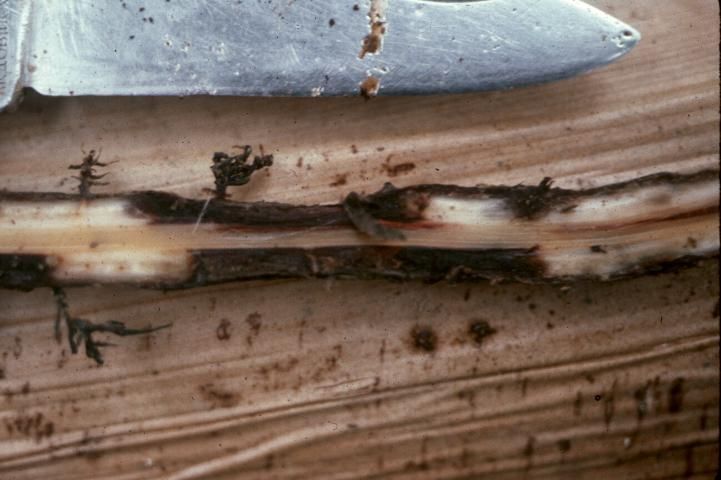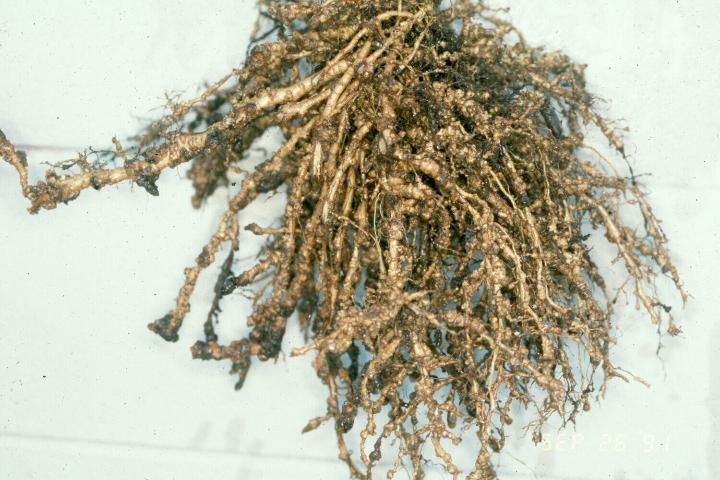Fruit and nut trees planted in Florida landscapes can appeal to the homeowner for many reasons, including fresh-tasting fruit of high quality and landscape beauty that adds to property value. If fruit plantings have so many wonderful attractions, why do we not see them in every yard? As for everything worth having, careful effort is needed to grow fruit and nuts successfully; every kind of plant has conditions most favorable for its growth and other situations in which it cannot thrive. Just as in real estate, the single most important factor for success is location, location, location. Many EDIS publications https://edis.ifas.ufl.edu/ provide important information about the needs of fruit and nut crops you might want to grow. Consider that information carefully when choosing your dooryard fruit crop(s). Soil conditions, exposure to sunlight, climatic conditions, and pest risks all can affect which fruit crops will grow best for you.
Pests
What are pests, and where do nematodes fall among them? Many kinds of creatures love the same fruits and nuts that we do. Pests are those that eat or otherwise damage plants we attempt to grow. Pests come in many forms and sizes and may affect our fruit crops in many ways. Microscopic viruses, bacteria, fungi, and nematodes cause many kinds of diseases that may affect the health of the plant or destroy the fruit. Many mites, beetles, caterpillars, and other arthropods feed on the plants and/or the fruits and nuts themselves, lay eggs in them, or carry some disease-causing microbes to them. Squirrels, mice, birds, rabbits, deer, and even bears love most of the fruits and nuts we grow and can be very sneaky about getting to them.
Pest management is the term for the entire body of tricks (practices, products, etc.) that we use to reduce the effects of pests on what we wish to have. Knowing what methods are most useful against the common pests of the crop(s) you are growing in your area is very useful during the critical decision process about what to plant and how to care for it. The first decision may well be that only specific varieties of that crop should be planted there or that a different crop altogether would be a better choice for your location.
What do nematodes do to fruit crops?
Plant-parasitic nematodes (Figure 1) are microscopic worm-like animals that live in soil or plant tissues. They acquire nutrients from plant tissues by perforating the tissue cells with a hollow, needle-like feeding structure called a stylet or spear (Figure 2). Different kinds of nematodes can be classified into one of three groups depending on how and where they feed on the plants:

Credit: R. P. Esser, Florida Department of Agriculture and Consumer Services, Division of Plant Industry; used with permission

Credit:
- Ectoparasitic nematodes are those that always remain outside the plant root tissues (Figure 3), feeding on surface cells or those within reach of their probing stylets (spears) from outside. The most common symptoms of damage from these nematodes are stunted or stubby root systems (Figure 4). A few kinds of ectoparasitic nematodes can transmit important plant viruses to the tissues on which they feed.

Credit: UF/IFAS

Credit: UF/IFAS
- Migratory endoparasitic nematodes move through root tissues, feeding on and killing relatively tender cells as they go (Figure 5). They weaken roots by physical damage to tender tissues, and their tunnels can dramatically reduce roots' resistance to invasion by fungi and bacteria. Common symptoms caused by these types of nematodes are dark, sunken lesions on roots and rotting of roots (Figure 6).

Credit: A. C. Hixson, UF/IFAS

Credit: UF/IFAS
- Sedentary endoparasitic nematodes penetrate young roots at or near the growing tip and establish permanent feeding sites there. After this they no longer need to move, so they swell as they mature (Figure 7). They steal nutrients, disrupt water and mineral transport, and also provide excellent sites for other pathogens and pests to invade the root. Affected roots may have galls or may simply appear to be poorly developed.

Credit: UF/IFAS
What kinds of nematodes may hurt fruit crops in Florida?
Many kinds of nematodes have been reported in and around the roots of various fruit and nut crops, but only a few are known to cause serious damage, including root-knot, lesion, ring, dagger, sting, and citrus nematodes. Following are notes about these important nematodes on fruits and nuts in Florida:
- Root-knot nematodes (Meloidogyne species) have been known to parasitize various fruit crops for over a century. Root-knot nematodes are sedentary endoparasites whose feeding usually stimulates growth of galls or knots on roots (Figures 8, 9). They disrupt normal formation and function of roots and allow easier entry into the roots for many fungi and bacteria which can cause disease or decay of the roots. Severe stunting of plants may occur, particularly of young plants (Figure 10). Damage to roots by root-knot nematodes can cause the plants to have nutrient deficiency symptoms such as chlorosis (yellowing) or "mouse-ear." Root-knot nematodes are severe pests of many fruit and nut crops grown in Florida, including peach, pecan, and figs.

Credit: UF/IFAS

Credit: UF/IFAS

Credit: A. P. Nyczepir
2. Lesion nematodes (Pratylenchus species) Lesion nematodes are migratory endoparasites that feed on many kinds of woody plants, including most fruit crops. They cause sunken lesions and rotting of plant roots and are moderately important pests of fruit crops.
3. Ring nematodes (Mesocriconema and related genera) Ring nematodes are small, cigar-shaped animals that are strictly ectoparasitic, browsing on tender tissues on the surface of the root. They are of low importance to most crops but can contribute to serious decline or total failure of many peaches and nectarines planted on susceptible root stocks. They are a contributing factor to the peach tree disease known as "peach tree short life" (Figure 11).

Credit: A. P. Nyczepir
4. Dagger nematodes (Xiphinema and related genera) Dagger nematodes are relatively large ectoparasites that feed mostly at or very near root tips, sometimes causing stunting of root growth or club-like growth of root tips. They are more important to grapes and stone fruits for their ability to store and transmit plant viruses (unusual among nematodes), which can cause diseases that severely weaken and even kill the crops. These nematodes can store and transmit both tobacco ringspot virus and tomato ringspot virus, which can cause "flat apple" condition of apples. They also reduce vigor and cause crumbly berries in bramble fruits and blueberries and can weaken grapevines.
5. Sting nematodes (Belonolaimus species) Sting nematodes are ectoparasitic nematodes native to sandy soil in Florida. Sting nematode can cause stunting and yield loss of most kinds of plants. Stunting is particularly severe on young plants.
6. Citrus nematodes (Tylenchulus semipenetrans) Citrus nematodes are sedentary endoparasites. The bodies of female citrus nematodes protrude from the surface of the tender roots upon which they are feeding, but their heads stay buried fairly deeply in the root tissues. They are common on citrus and also infect persimmon, olive, and a few other fruit crops. Feeding by large numbers of citrus nematodes can significantly weaken fruit and nut trees.
Diagnosis: how can I tell if nematodes are a likely problem?
If your fruit or nut planting is still in the planning stage, knowing what nematodes are present may affect your planting decisions. Determine which species and even varieties of plants would do best and/or worst with the nematodes you know are present in your environment. It certainly may influence your site preparation.
There are three main ways to know about the kinds of nematodes that are at your planting site:
- Laboratory analysis of soil and root samples can provide the most specific information about what kinds of nematodes are present, and can detect and quantify all kinds of plant-parasitic nematodes that may be present in the sample. The University of Florida Nematode Assay Lab will do this for a nominal fee, as can several private plant diagnostic labs.
- Any known history of nematode problems on something grown there before gives important information about potential future problems. Nematodes that were present before are very likely to still be present.
- One group of nematodes important to fruit crops causes recognizable symptoms on some plants that may be growing at the site. Root-knot nematodes normally cause visible swollen growths called "galls" on roots of infected plants (Figures 8, 9). The number and severity of galls on roots may be used to detect and estimate the severity of an infestation of root-knot nematodes.
Management: what can I do about them?
The simple presence of nematodes where you have fruits growing or where you hope to plant fruit does not mean disaster. Nearly every spoonful of soil has many nematodes in it. It is almost certain that some plant-parasitic nematodes occur around the roots of any plant growing in field soil. It is only when the balance shifts heavily in favor of the nematodes that they become serious pests. In most cases, an otherwise healthy plant will tolerate a few of one or several kinds of nematodes that can feed on its roots.
Chemical Nematicides
There are no chemical nematicides labeled for use on dooryard fruit and nuts that have been effective in University of Florida trials.
Bionematicides
There are several bionematicides on the market that may be used legally on non-commercial fruit and nut trees. However, at this time these have either not been thoroughly evaluated for efficacy in University of Florida trials or they have been tested with poor results.
Cultural Practices
There are many steps you can take to avoid or at least minimize nematode interference with growing the fruit or nut crops you want. While we will discuss each of those steps individually, your best chance of managing nematodes successfully will require combination of as many of these steps as possible into an integrated nematode management program. Some of these tactics may seem futile or even silly, but each can make a real contribution to suppression of nematode problems.
- Pest exclusion is the most important strategy to prevent nematode problems. Sometimes plants come from the nursery already infested with nematodes. Avoid introducing nematodes that you do not have on your property already by carefully inspecting plant roots before planting. Do not use plants whose roots have galls (Figures 8, 9), are rotten, or have other abnormalities.
- Do not plant a crop that is highly susceptible to one or more kinds of nematode present on your site.
- If you must plant in areas with high risk of nematodes for your crop, consider soil replacement, i.e., dig out and remove all soil from a generous planting hole (at least 3 ft diameter X 2 ft deep) and replace it with soil free of nematodes and other pests. The crop roots eventually will grow out of the clean soil volume and there will be some movement of nematodes into the clean soil, but the plant will have a jump-start on them by having some time to grow nematode-free.
- Choose varieties or rootstocks that are least susceptible to specific nematodes at the site. 'Nemaguard' and 'Flordaguard' peach rootstocks have resistance to the southern root-knot nematode (Meloidogyne incognita) and Javanese root-knot nematode (Meloidogyne javanica). However, only 'Floraguard' has resistance to the peach root-knot nematode (Meloidogyne floradensis). Therefore, the University of Florida recommends 'Flordaguard' rootstock for use in Florida. 'Lovell' rootstock, recommended for peaches to be grown to resist ring nematodes in sandy soils in some areas of the United States, is not recommended in Florida because it is extremely susceptible to root-knot nematodes.
- Soil amendments are any organic materials that might be added to soil to improve its physical, chemical, or biological characteristics. Compost or raw manure, leaves, or other organic products provide benefits for fruit tree growth and help trees tolerate nematodes better. The amendments should be incorporated into the planting hole for new plantings and added to the soil surface for established plants.
- Soil solarization involves covering soil to be treated with clear polyethylene for an extended period in the summer. Solarization of field planting sites in Florida may be disappointing because it rarely heats soil sufficiently at the recommended depth (5–6 inches is common) to provide adequate control for the entire root zone area. However, a limited volume of otherwise good topsoil or soil mix can be solarized by completely enclosing it in clear polyethylene film and keeping the soil depth at no more than 6 inches. It should be located to receive full sun all day and should be exposed 6 weeks or longer in June and July. This might be a good way to reduce nematodes and fungi as problems in soil or a soil mix to be used in soil replacement.
Key Considerations in Managing Nematodes in Fruit Tree Plantings
A. Purchase nematode-free planting stock from reputable dealers. Reject any whose roots have knots or galls or appear rotten.
B. Buy varieties with nematode-resistant rootstocks when available; these are only available for peach, nectarine, and plum.
C. When planting, use copious quantities of organic matter. If nematodes are suspected, remove native soil and replace with nematode-free potting soil.
D. Water plants according to need; do not allow them to go through water stress.
E. Fertilize plants and follow good cultural practices. This allows plants to tolerate more nematodes.
F. Keep the area within the fruit tree drip line free of plants (ornamentals and weeds) that could serve as hosts to nematodes on fruit trees. These plants will also compete with the fruit plants for water and nutrients.
G. Having a Nematode Assay conducted before planting can help you select plants less likely to suffer damage from the nematodes present at your location.
For each kind of fruit crop, we can consider three risk levels of severity of nematode pests:
- Severe pests whose simple presence poses a serious threat to the crop.
- Moderate pests that may co-exist with the crop without causing serious injury under normal circumstances but occasionally can cause serious stress and damage the crop severely.
- Limited pests that may be associated with fruit crop roots even in fairly high numbers without causing any adverse effect but may, under very unusual circumstances, cause significant stress to the crop.
Table 1. Deciduous fruit crops and nematodes most likely to affect them in Florida dooryard plantings.